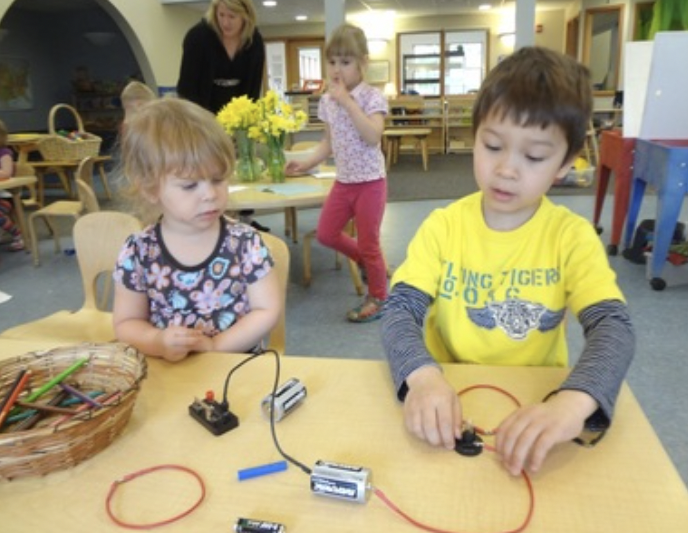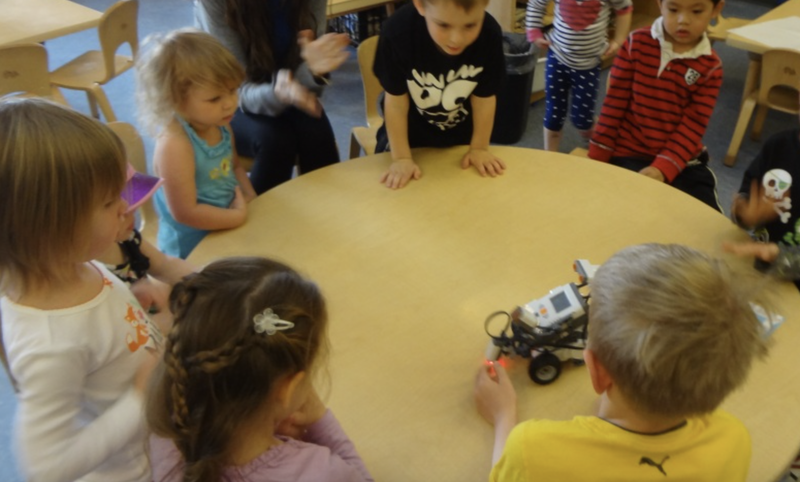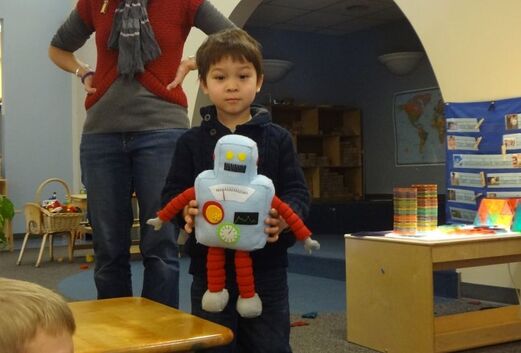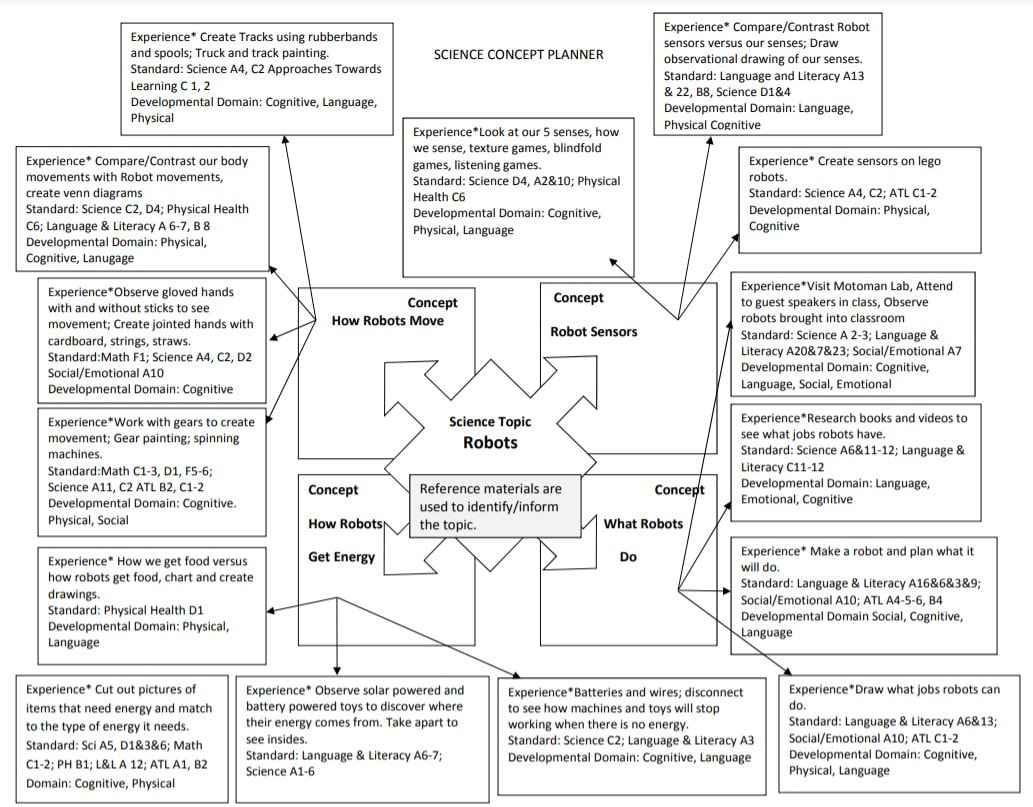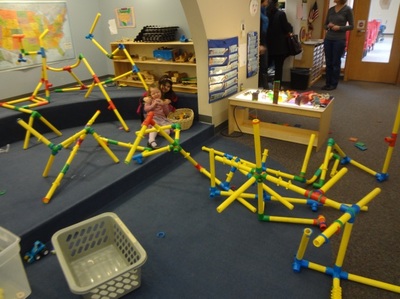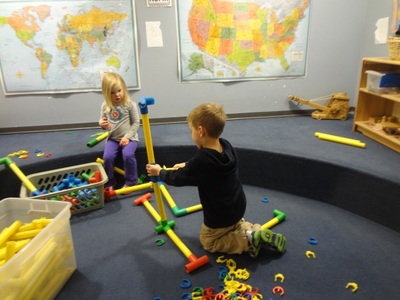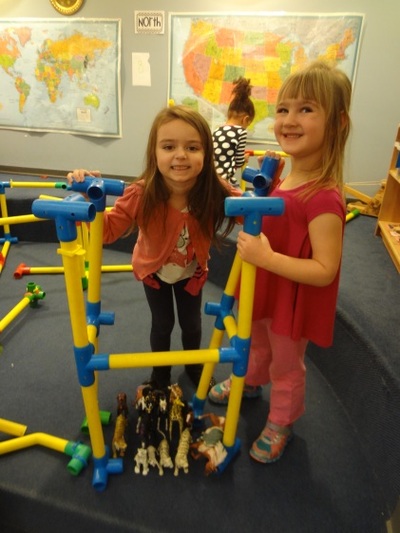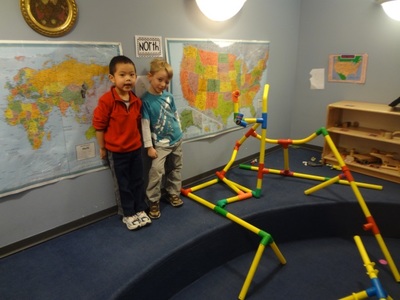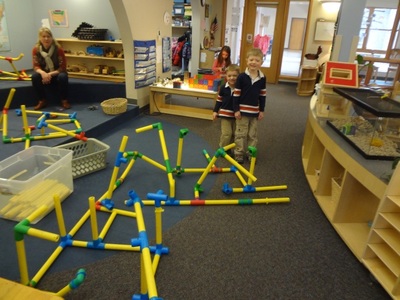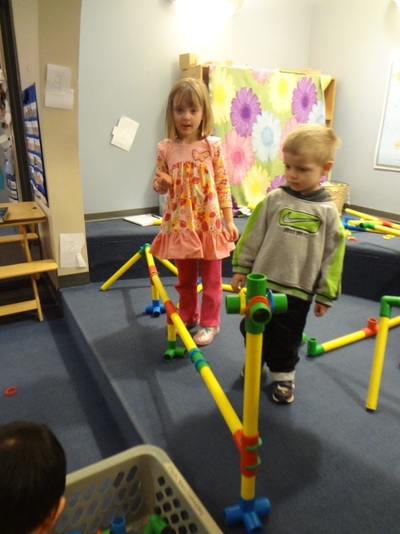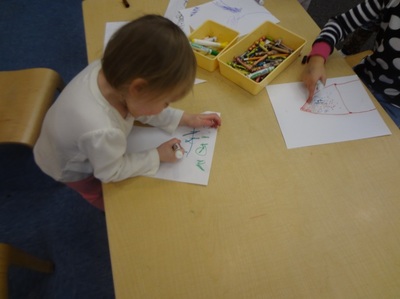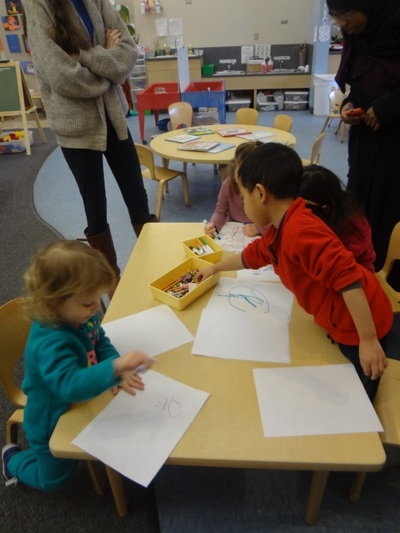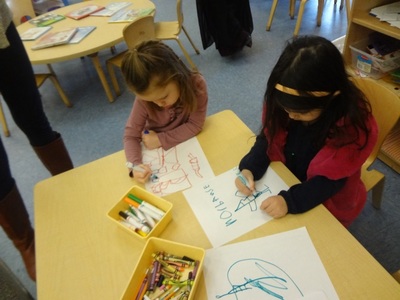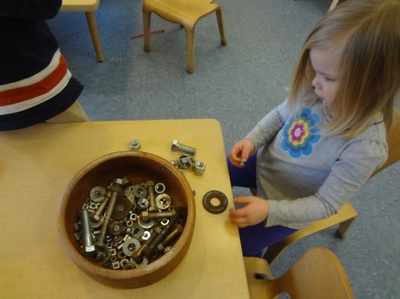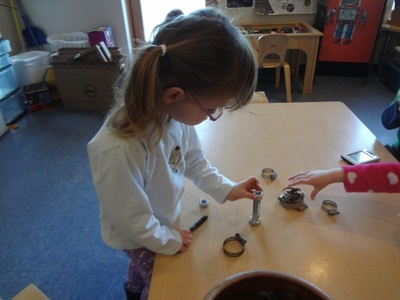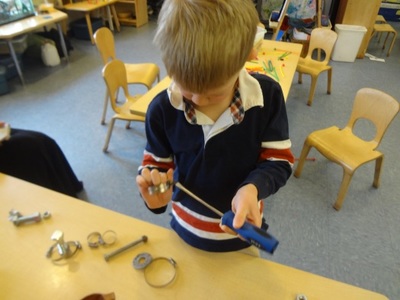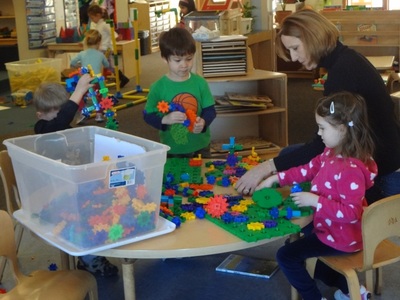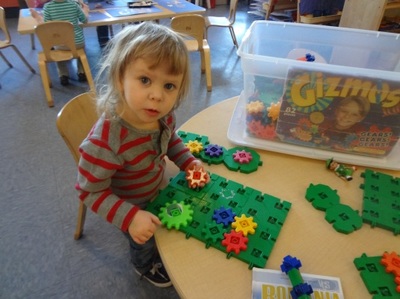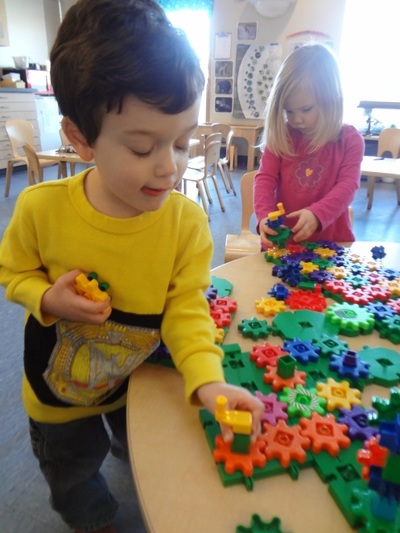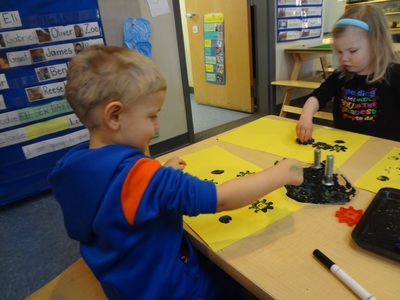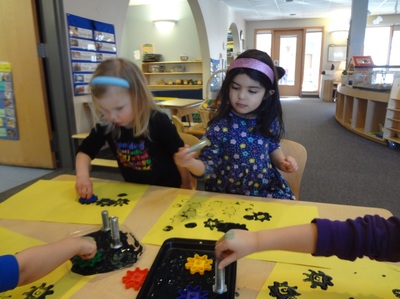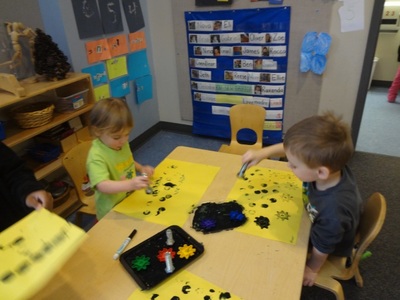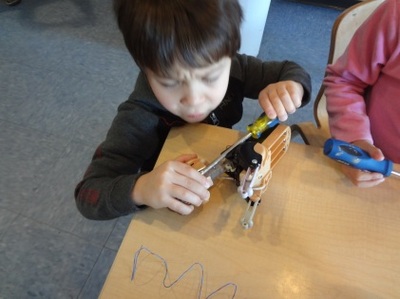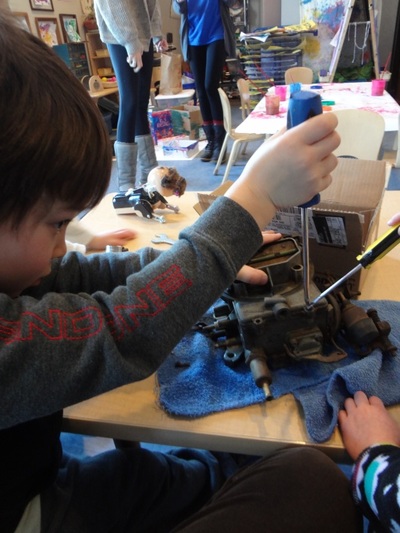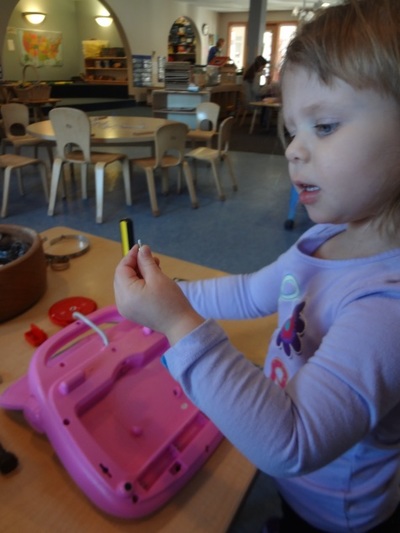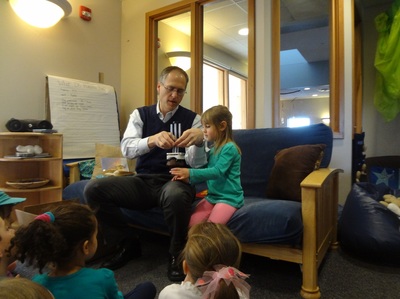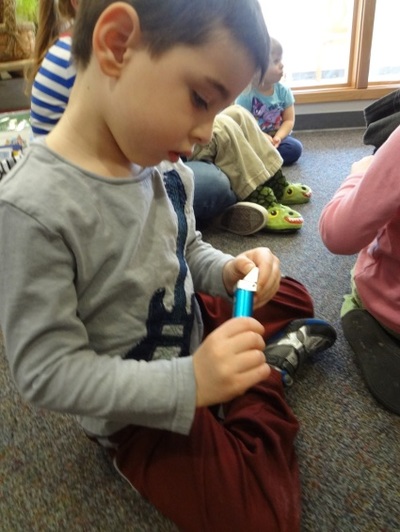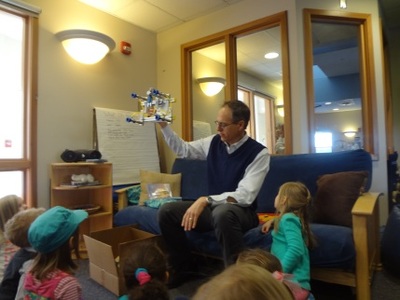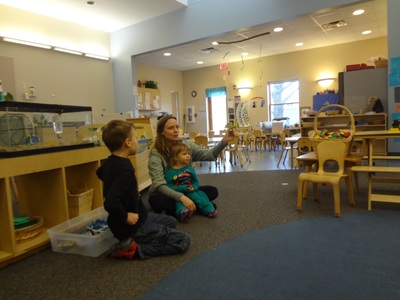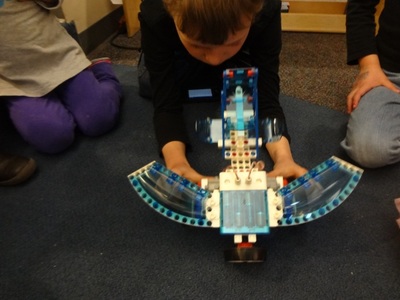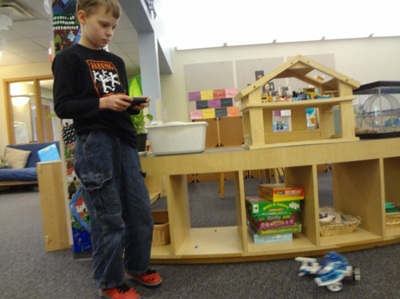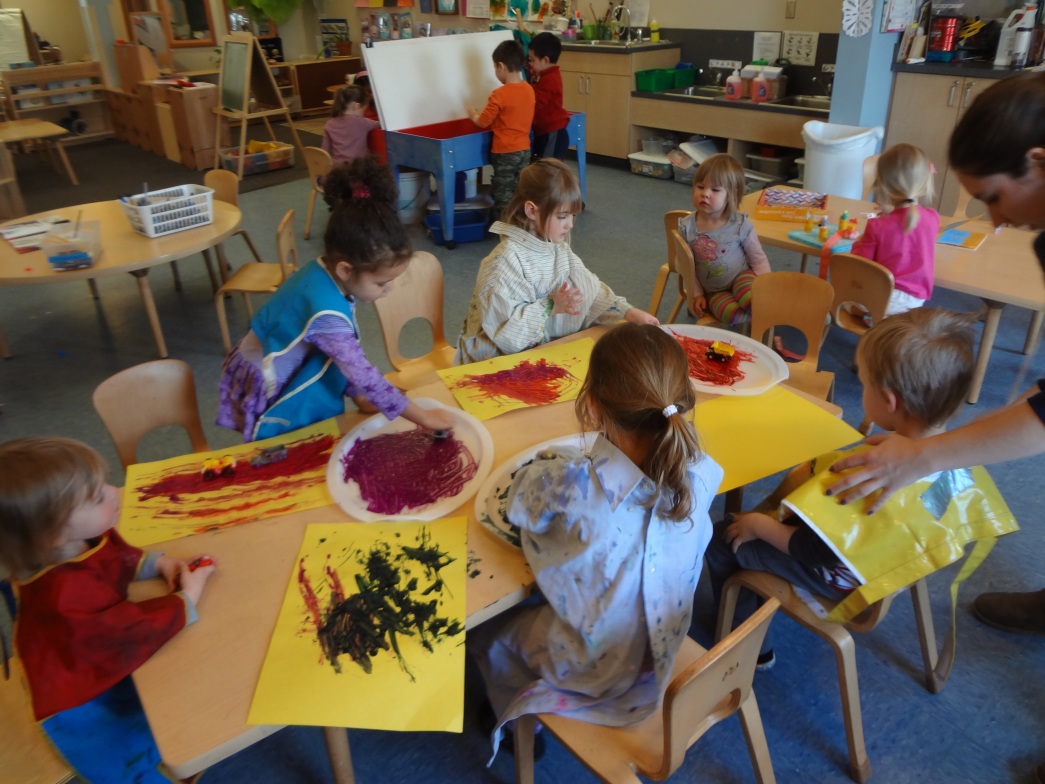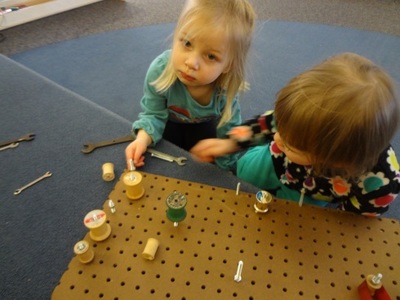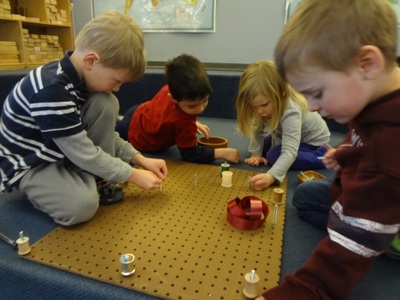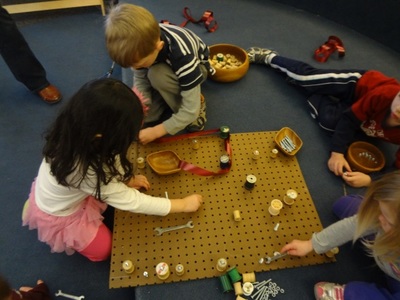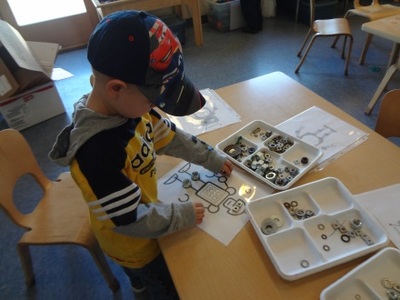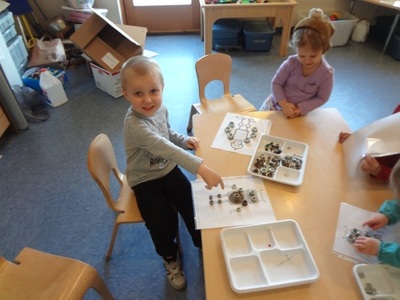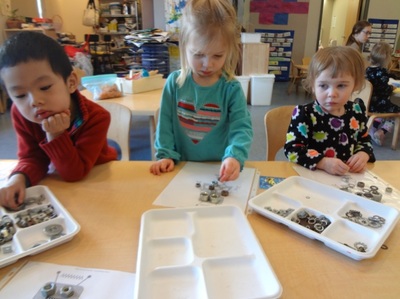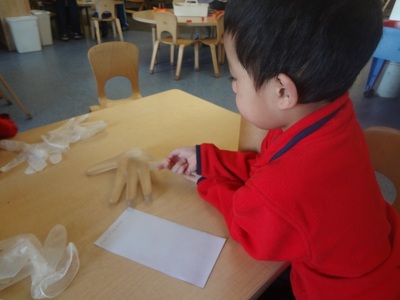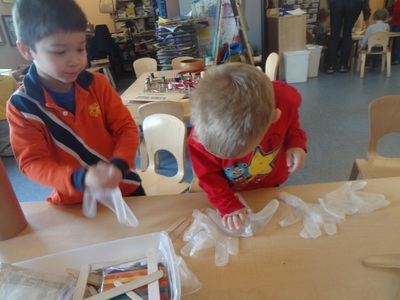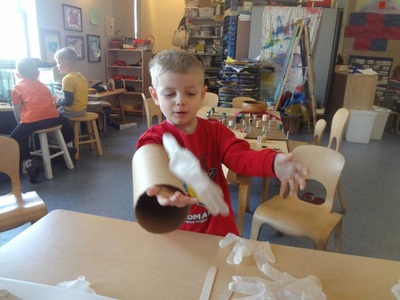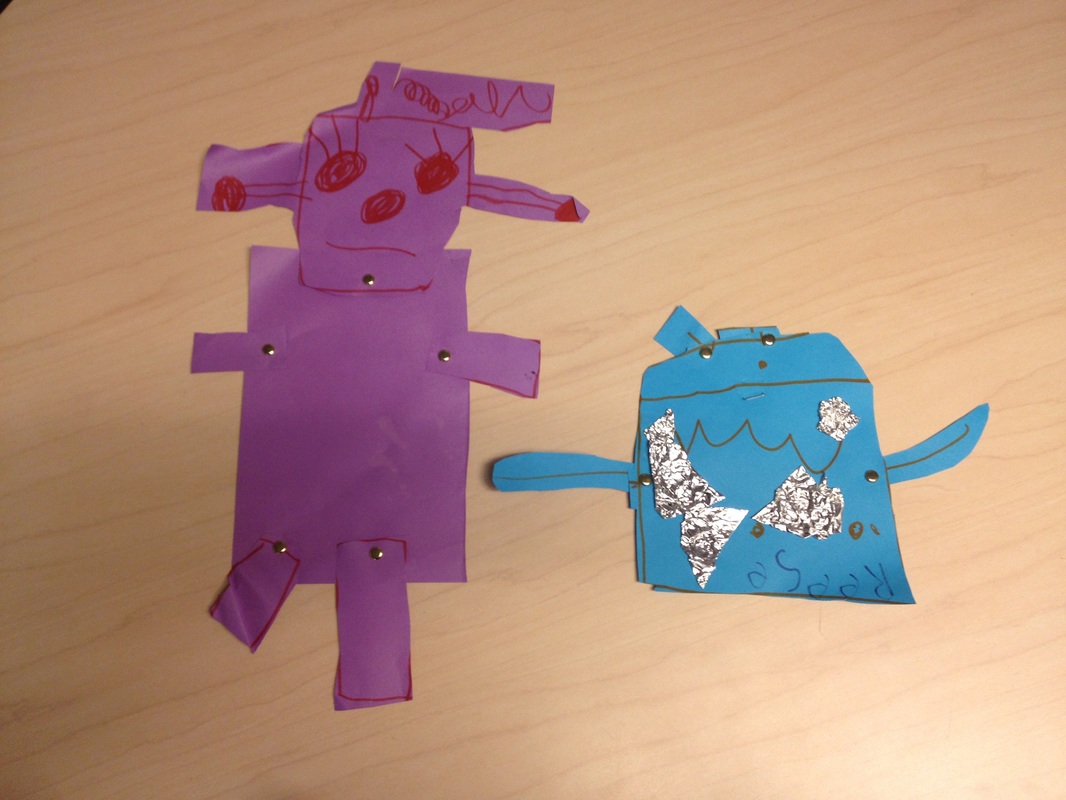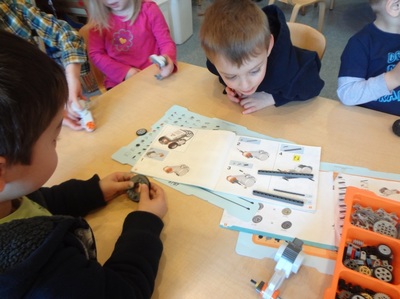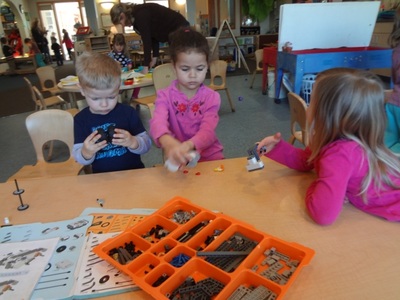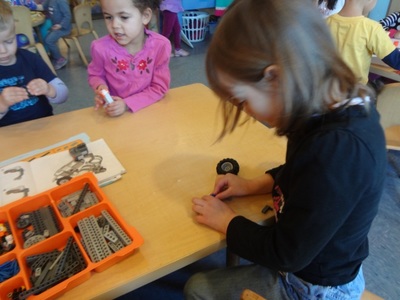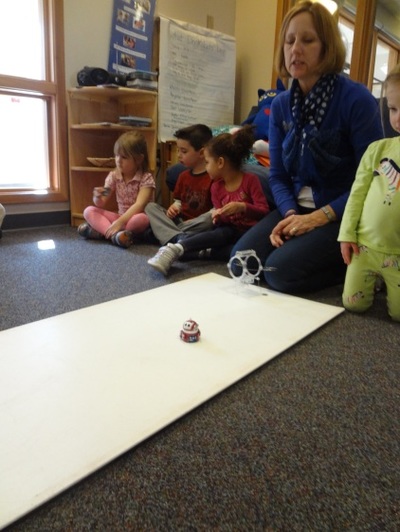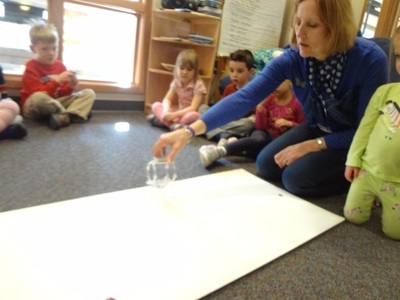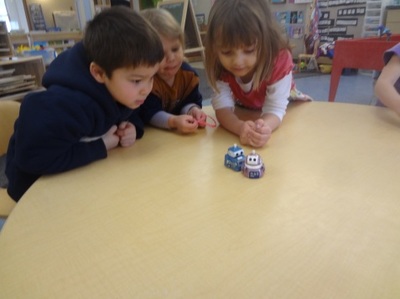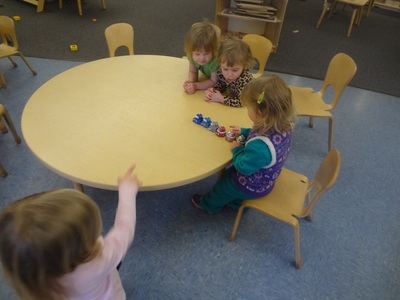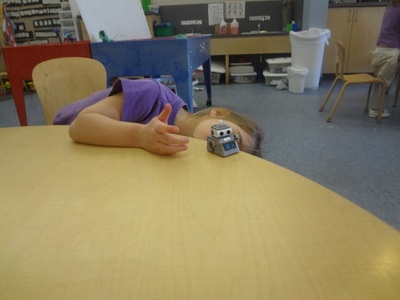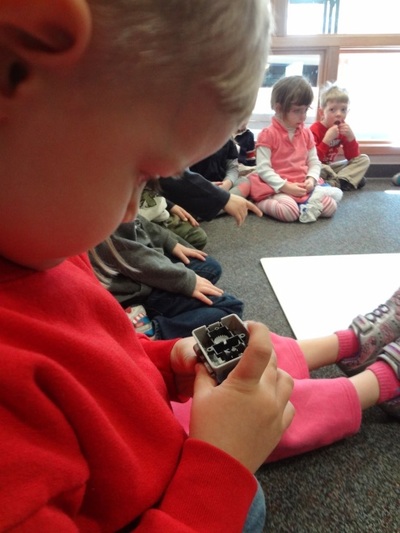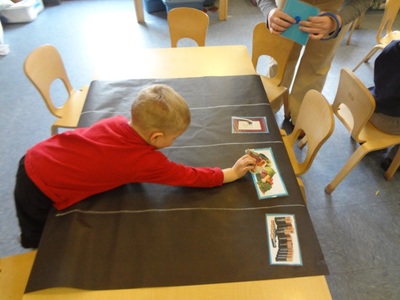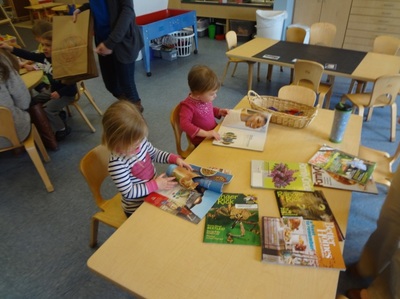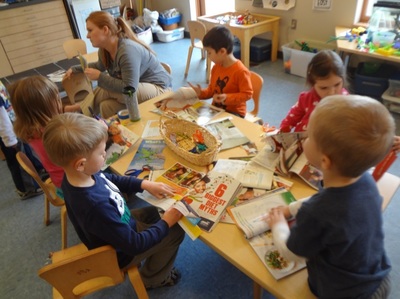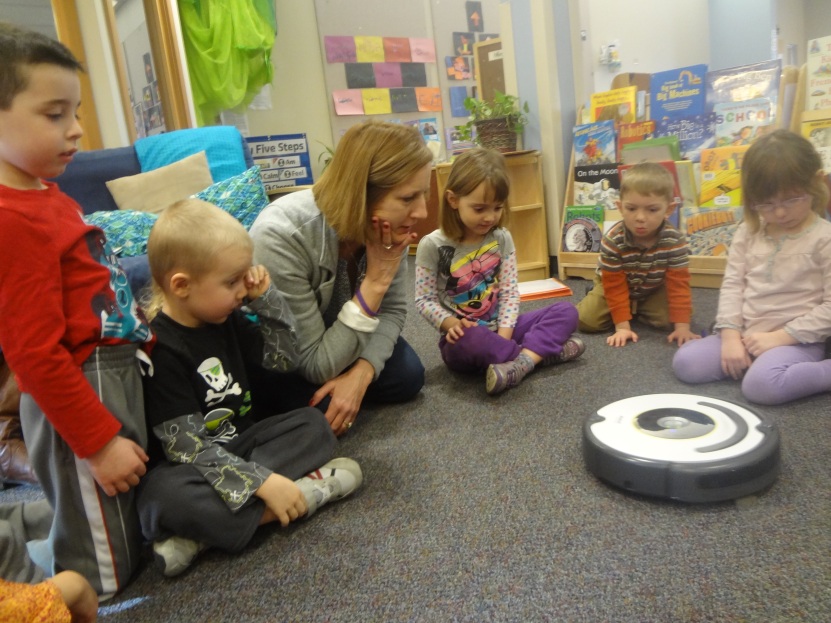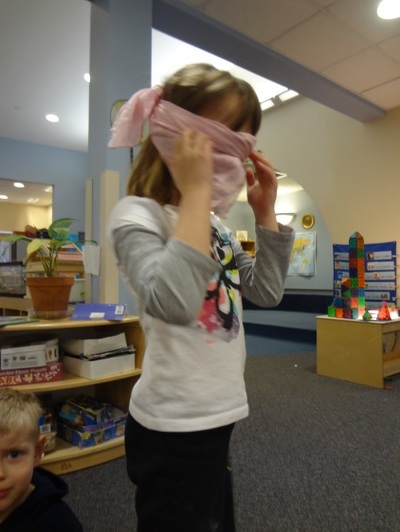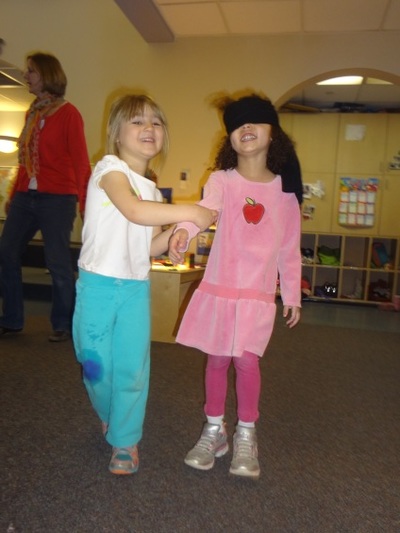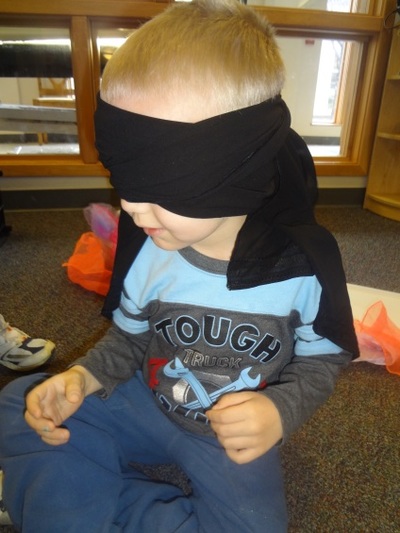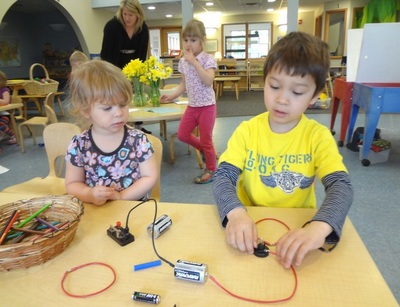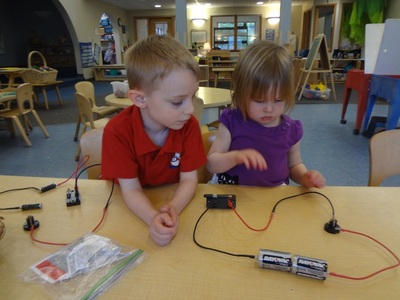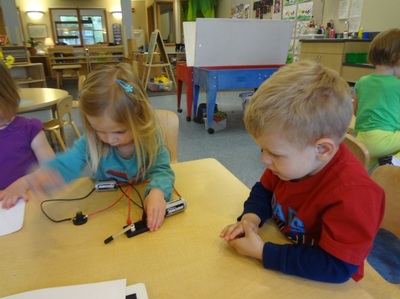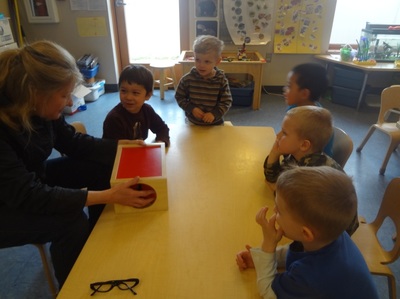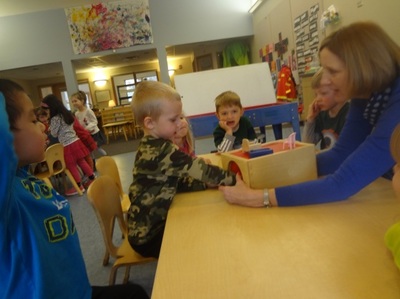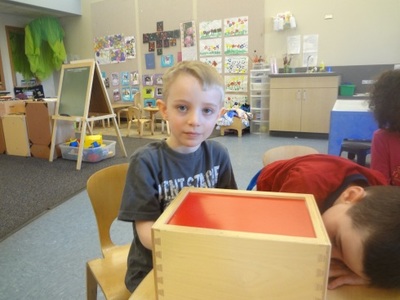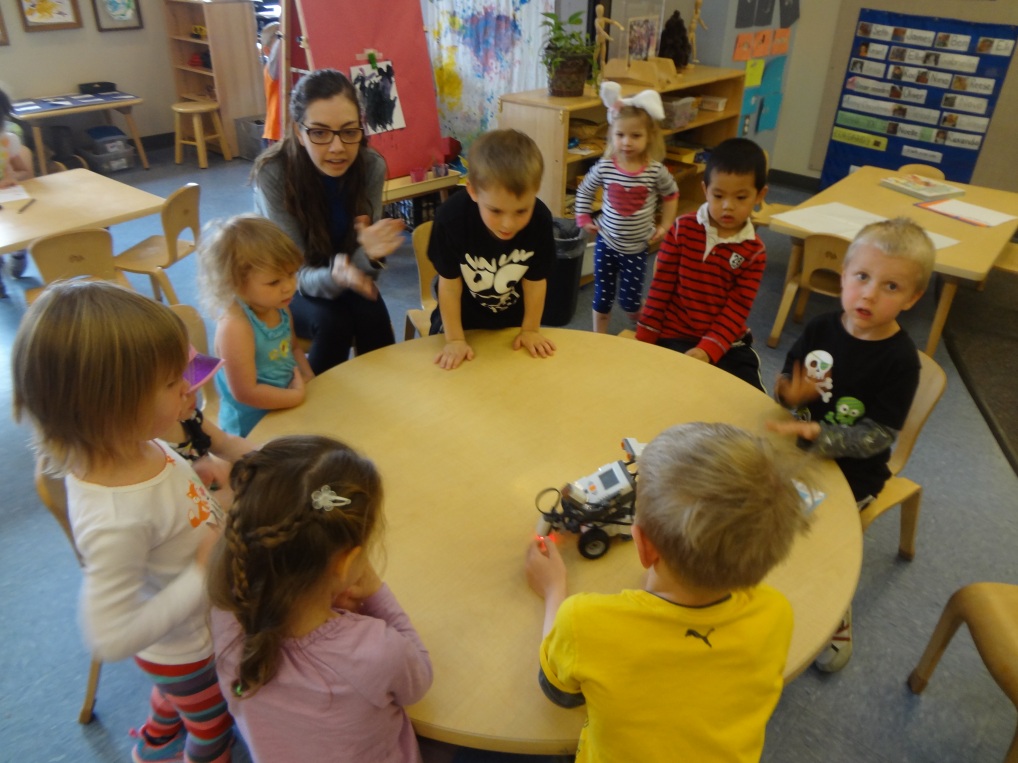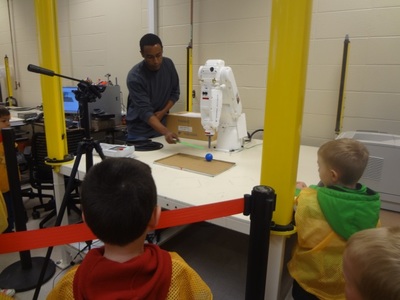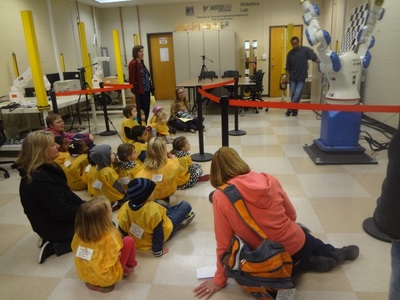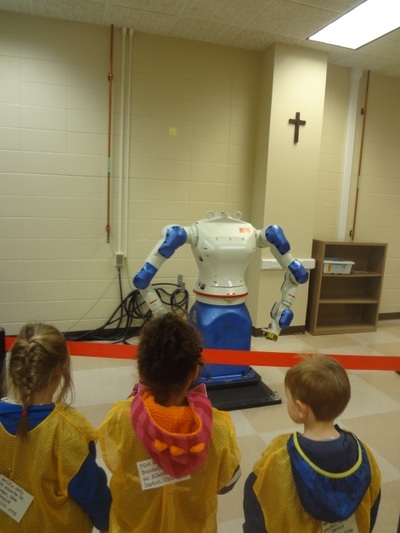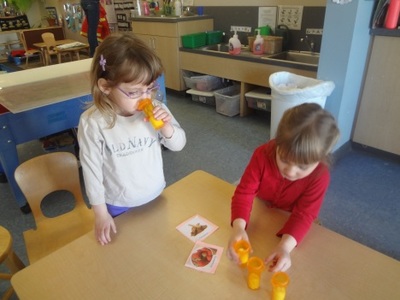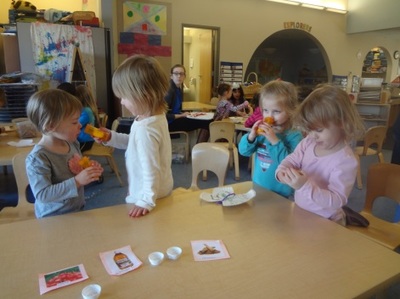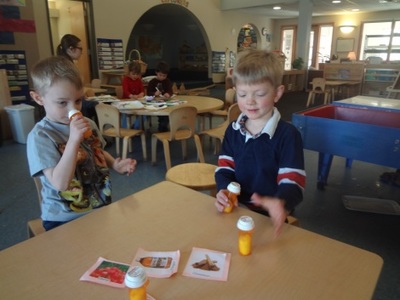Robots |
Preschool Investigation
RATIONALEWhile working on a past investigation of fabric, one the of the children wanted to make a robot out of fabric. The teachers and the child then worked together and were successfully able to create a plush robot. The other children became very interested in the stuffed robot and even another child and his parent made one at home. Many of the children began to talk about robots and pretended to act like robots in the block area of the classroom. At this time, the teachers then discovered that the children have a misconception of what a robot truly is. Many of them believe that robots are cartoon figures, humanoids, or the typical square face/rectangle body figure. And the children thought the only purpose of a robot was to destroy objects. The teachers wanted to help the children look more closely at robots and help them understand that robots come in all shapes/sizes and have a multitude of helpful uses. The four main concepts for this investigation are: sensors, movement, energy, and intelligence. Robots must have all four parts in order to be considered a robot.
|
HOW IT RELATES TO S.T.E.M.
We investigated each area by making connections to our own body's senses, movement, intelligence, and energy. During this project we dove into the disciplines of design, building, programing, and testing robots using a combination of physics, mechanical engineering, electrical engineering, structural engineering, mathematics, and computer science. The teachers recognized this as an opportunity to introduce the use of mathematics, as well as the role of engineers while investigating robots. Also, a strong focus on the use and role of technology emerged during this investigation. |
CONCEPT PLANNER
DOCUMENTATION OF PROCESS
BUILDING BIG
As we began to look at robots, the children showed interest in building large items. We brought in large connecting building tubes to put in the block area. The children worked together to build different robots and shapes. They worked to connect pieces and helped each other build really large items. The children shared with each other and described what each of their robots were doing.
As we began to look at robots, the children showed interest in building large items. We brought in large connecting building tubes to put in the block area. The children worked together to build different robots and shapes. They worked to connect pieces and helped each other build really large items. The children shared with each other and described what each of their robots were doing.
DRAWING ROBOTS
After talking with the children about their preliminary knowledge of robots, the children had an opportunity to draw a picture of what they thought a robot looked like. Many of the children drew pictures of very stereotypical square-like robot figures. Some of the children began to think about what their robots would do as they drew their pictures.
After talking with the children about their preliminary knowledge of robots, the children had an opportunity to draw a picture of what they thought a robot looked like. Many of the children drew pictures of very stereotypical square-like robot figures. Some of the children began to think about what their robots would do as they drew their pictures.
ASSEMBLING AND SORTING NUTS & BOLTS
To get a better understanding of what is inside a robot the children had the chance to work with different mechanical parts. Different sized gears, wrenches, bolts and washers were put out for the children to explore. Some of the children worked to sort the materials by size, laying the items out from smallest to largest. And some of the children worked to find the pieces that would fit together. They tried out different sized wrenches to twist nuts and bolts while experimenting to find what washers fit on certain sizes bolts.
ASSEMBLING: Using their fine motor skills the children assembled the various sizes of nuts and bolts. They had to look at the different sizes and by using their reasoning skills they had figure out which ones went together.
SORTING: Various sizes of nuts and bolts were put out for the children to sort. The children sorted them according to different attributes as in size and length. The children worked individually as well as in groups to do the sorting.
To get a better understanding of what is inside a robot the children had the chance to work with different mechanical parts. Different sized gears, wrenches, bolts and washers were put out for the children to explore. Some of the children worked to sort the materials by size, laying the items out from smallest to largest. And some of the children worked to find the pieces that would fit together. They tried out different sized wrenches to twist nuts and bolts while experimenting to find what washers fit on certain sizes bolts.
ASSEMBLING: Using their fine motor skills the children assembled the various sizes of nuts and bolts. They had to look at the different sizes and by using their reasoning skills they had figure out which ones went together.
SORTING: Various sizes of nuts and bolts were put out for the children to sort. The children sorted them according to different attributes as in size and length. The children worked individually as well as in groups to do the sorting.
GEARS
To begin our look into different robot concepts we began with movement. To help the children understand different ways that robots can move we purchased many different kinds of gears. The children began to explore how they could connect gears vertically instead of just horizontally. The children worked with small metal gears and were able to see the similarities and difference between the play gears and the small metal gears.
To begin our look into different robot concepts we began with movement. To help the children understand different ways that robots can move we purchased many different kinds of gears. The children began to explore how they could connect gears vertically instead of just horizontally. The children worked with small metal gears and were able to see the similarities and difference between the play gears and the small metal gears.
PRINTING BOLTS
To get a better look at what bolts feel like and what they look like we took an artistic approach with the children. The children used the bolts and gears as stamps. The children dipped different bolts and gears in to paint and then used them to make patterns on their paper. The children had the opportunity to look closer at the bolts and gears to see what shape they created, to feel them in their hands, and to see what imprint they left when stamped.
To get a better look at what bolts feel like and what they look like we took an artistic approach with the children. The children used the bolts and gears as stamps. The children dipped different bolts and gears in to paint and then used them to make patterns on their paper. The children had the opportunity to look closer at the bolts and gears to see what shape they created, to feel them in their hands, and to see what imprint they left when stamped.
WHAT'S INSIDE?
To get a better look at how machines and what they are made of ,the teachers found some broken objects for the children to take apart. The children were able to use screwdrivers and wrenches to try to take apart a carburetor, a toy laptop, some cell phones and a "robot" dog. The children were able to see what was inside all of these items. The children found screws, gears, batteries and lots of small parts. Additionally, some of the children tried putting the items back together.
To get a better look at how machines and what they are made of ,the teachers found some broken objects for the children to take apart. The children were able to use screwdrivers and wrenches to try to take apart a carburetor, a toy laptop, some cell phones and a "robot" dog. The children were able to see what was inside all of these items. The children found screws, gears, batteries and lots of small parts. Additionally, some of the children tried putting the items back together.
ROBOT HANDS
To learn more about how robots move and what they do, we asked a guest speaker to come and visit the class. Noelle's father works at a company that makes robotic hands and fingers. He showed the children different types of fingers that can be added onto robotic hands. He showed us how some bend and scoop. The item that caught the classes attention was a claw that is made especially to pick up muffins. Noelle's dad brought in a muffin and demonstrated how the claw picks up the muffin without damaging it. The children passed around the various robotic fingers and experimented on how they move.
To learn more about how robots move and what they do, we asked a guest speaker to come and visit the class. Noelle's father works at a company that makes robotic hands and fingers. He showed the children different types of fingers that can be added onto robotic hands. He showed us how some bend and scoop. The item that caught the classes attention was a claw that is made especially to pick up muffins. Noelle's dad brought in a muffin and demonstrated how the claw picks up the muffin without damaging it. The children passed around the various robotic fingers and experimented on how they move.
LEGO ROBOT DEMONSTARATION
Nova's big brother is in a Robot League and he and his mom came in the demonstrate to the class how his robots work. Nova's brother Ori talked about how he built the robots. He showed the class some of the robots that had sensors and how they could sense how close they were to large objects. Some of the robots could be controlled by a mobile phone. Ori explained that the robots get energy and power from batteries and that is what makes they move and power on. The children watched as Ori had the robots move around in front of them.
Nova's big brother is in a Robot League and he and his mom came in the demonstrate to the class how his robots work. Nova's brother Ori talked about how he built the robots. He showed the class some of the robots that had sensors and how they could sense how close they were to large objects. Some of the robots could be controlled by a mobile phone. Ori explained that the robots get energy and power from batteries and that is what makes they move and power on. The children watched as Ori had the robots move around in front of them.
MAKING TRACKS
The children learned that robots move in various ways. During circle time, the children had been researching different ways that they want to see robots move, such as on feet, on wheels and with tracks. To study these different methods of movement, the children had the opportunity to create tracks through paint and then observe them closer as they moved them across their papers.
The children learned that robots move in various ways. During circle time, the children had been researching different ways that they want to see robots move, such as on feet, on wheels and with tracks. To study these different methods of movement, the children had the opportunity to create tracks through paint and then observe them closer as they moved them across their papers.
SPINNING SPOOLS
To get a better sense of how robots move, the children played the Goldieblox spinning machine game. During this game the children created a spinning machine that moved the different characters. After looking at this spinning machine, the teachers helped the children create their own spinning machine using nuts, bolts, spools and ribbon. The children chose where they wanted the nuts and bolts to be and then put the spools on top. They then used Velcro to attach the ribbons to the spools and wound them up. The children then took the end of the ribbon and wove it around the other spools on the board and made multiple spools spin.
To get a better sense of how robots move, the children played the Goldieblox spinning machine game. During this game the children created a spinning machine that moved the different characters. After looking at this spinning machine, the teachers helped the children create their own spinning machine using nuts, bolts, spools and ribbon. The children chose where they wanted the nuts and bolts to be and then put the spools on top. They then used Velcro to attach the ribbons to the spools and wound them up. The children then took the end of the ribbon and wove it around the other spools on the board and made multiple spools spin.
NUTS AND BOLTS OF ROBOTS
After sorting nuts and bolts by shape, the teachers wanted the children to see how they can be put together. The children chose a robot and then used one-to-one one correspondence to count the nuts and bolts and then add them to empty spaces on the robot pictures. The children were able to create their own robots using just nuts and bolts.
After sorting nuts and bolts by shape, the teachers wanted the children to see how they can be put together. The children chose a robot and then used one-to-one one correspondence to count the nuts and bolts and then add them to empty spaces on the robot pictures. The children were able to create their own robots using just nuts and bolts.
LOOKING AT JOINTS
While looking at movement and how robots move we wanted to also study joints. To help the children better understand this concept and what joints are and how they help us bend and move, we looked at our own arms and legs. We also imagined how we would look if we didn't have joints. To do so we had the children place a large tube on their arm and hands and then try to do everyday tasks. The children realized how difficult it was to use their arms without a joint. The children also worked with two different types of hands, one with joints and one without. The hands were made out of plastic gloves, the one without joints had popsicle sticks inside. The children tried to bend this hand and fingers but investigated how the hand without joints would not bend well and was difficult to use.
While looking at movement and how robots move we wanted to also study joints. To help the children better understand this concept and what joints are and how they help us bend and move, we looked at our own arms and legs. We also imagined how we would look if we didn't have joints. To do so we had the children place a large tube on their arm and hands and then try to do everyday tasks. The children realized how difficult it was to use their arms without a joint. The children also worked with two different types of hands, one with joints and one without. The hands were made out of plastic gloves, the one without joints had popsicle sticks inside. The children tried to bend this hand and fingers but investigated how the hand without joints would not bend well and was difficult to use.
"It has sticks, if we put the sticks out it could move"- Grant
"Have sticks, take stick out, then moves, that’s how it works"- Seth
"It needs joints to bend"- Rocco
"Toothpick is not letting the finger move, put joints in it to make it move" – Ellie
"Sticks making the fingers not move, if there wasn’t sticks in them they would"- Nina
MAKING JOINTS ON ROBOTS
After looking at movement and then investigating how joints help people and robots move, the children had an opportunity to make robots with joints. The children cut out different shapes to create arms and legs for their robots. The children used brackets to add the arms and legs and heads to their robot bodies. The teacher discussed how the brackets were like joints that we have in our own bodies. The brackets allowed the robots to move.
After looking at movement and then investigating how joints help people and robots move, the children had an opportunity to make robots with joints. The children cut out different shapes to create arms and legs for their robots. The children used brackets to add the arms and legs and heads to their robot bodies. The teacher discussed how the brackets were like joints that we have in our own bodies. The brackets allowed the robots to move.
BUILDING MOVEMENT IN OUR LEGO ROBOT
Over the course of this investigation the children are going to help build a Lego robot. After looking at how robots move, the children had the opportunity to build the body of the Lego robot and design how it would move. The children found lots of wheels to help the robot move and decided on a few to put on the robot so it would move. The children helped build their class robot, and also created some of their own robots with the wheels and other pieces.
Over the course of this investigation the children are going to help build a Lego robot. After looking at how robots move, the children had the opportunity to build the body of the Lego robot and design how it would move. The children found lots of wheels to help the robot move and decided on a few to put on the robot so it would move. The children helped build their class robot, and also created some of their own robots with the wheels and other pieces.
WHAT MAKES A ROBOT GO?
During circle time the children viewed different types of robots. One robot looked like a bug and vibrated around. The other robots were wind up robots that drove around. The children passed these robots around the circle. Later at the table the children had the opportunity to try hand winding up some of the robots and moving them around the table. The children also worked together to take one of the small robots apart to see what was inside. Inside the children found lots of gears.
During circle time the children viewed different types of robots. One robot looked like a bug and vibrated around. The other robots were wind up robots that drove around. The children passed these robots around the circle. Later at the table the children had the opportunity to try hand winding up some of the robots and moving them around the table. The children also worked together to take one of the small robots apart to see what was inside. Inside the children found lots of gears.
WHERE DOES ENERGY COME FROM?
While learning about robots we decided to look at how robots get energy. To look more closely at the idea of energy the class also looked at how people get energy. After a few experiences and many discussions during circle time we decided to make a chart to see where different items get energy. The different types of energy were sun, batteries, electricity or outlets, and lastly food. The children had the chance to look through different magazines and pick out different items and cut them out. Once the children had picked their different items then they had to decide how that items get its energy and put it on the chart.
While learning about robots we decided to look at how robots get energy. To look more closely at the idea of energy the class also looked at how people get energy. After a few experiences and many discussions during circle time we decided to make a chart to see where different items get energy. The different types of energy were sun, batteries, electricity or outlets, and lastly food. The children had the chance to look through different magazines and pick out different items and cut them out. Once the children had picked their different items then they had to decide how that items get its energy and put it on the chart.
ROOMBA
While learning about the purpose of robots and learning about how they move, the children observed a Roomba vacuum. Jackson's mom brought in their Roomba that they use at home. During circle time the children discussed how the purpose of the Roomba is the vacuum and clean the carpet. The children saw how the robot drives itself around and cleans up the floor. At the tables the children looked under the Roomba and discovered the wheels that helps the robot move around.
While learning about the purpose of robots and learning about how they move, the children observed a Roomba vacuum. Jackson's mom brought in their Roomba that they use at home. During circle time the children discussed how the purpose of the Roomba is the vacuum and clean the carpet. The children saw how the robot drives itself around and cleans up the floor. At the tables the children looked under the Roomba and discovered the wheels that helps the robot move around.
EXPLORING OUR SENSE OF SIGHT
To help the children better understand their sense of sight and how it helps them to focus on other senses the children played the blindfold game. The children thought it was a fun game and were laughing and giggling the entire time. After the children reached their destination they took off the blindfolds and talked about what other senses they used since they could not use their eyes. They then talked about how they had to rely on their ears and to listen to what their friends were telling them and how they used their hands/sense of touch to feel objects in their path.
To help the children better understand their sense of sight and how it helps them to focus on other senses the children played the blindfold game. The children thought it was a fun game and were laughing and giggling the entire time. After the children reached their destination they took off the blindfolds and talked about what other senses they used since they could not use their eyes. They then talked about how they had to rely on their ears and to listen to what their friends were telling them and how they used their hands/sense of touch to feel objects in their path.
UNDERSTANDING CIRCUITS
While learning about robots we also wanted to look at circuits and allow the children the opportunity to build one. During table work the children were able to use wires, batteries, a switch and a light bulb to create a circuit. The children began with just the light bulb and batteries and then added the switch. The children worked on creating their circuits for a week and then were given a pencil and paper so they could draw how the circuit worked.
While learning about robots we also wanted to look at circuits and allow the children the opportunity to build one. During table work the children were able to use wires, batteries, a switch and a light bulb to create a circuit. The children began with just the light bulb and batteries and then added the switch. The children worked on creating their circuits for a week and then were given a pencil and paper so they could draw how the circuit worked.
FEELING WITH OUR HANDS
While learning about robot sensors, we first learned about our own sensors or senses. To further learn about the sense of touch we explored a feeling box. The teachers put different objects inside the box and the children would reach inside the box and describe what the objects felt like. The children would then try to predict what the object was. The teachers discussed what parts of their bodies they were using to sense with.
While learning about robot sensors, we first learned about our own sensors or senses. To further learn about the sense of touch we explored a feeling box. The teachers put different objects inside the box and the children would reach inside the box and describe what the objects felt like. The children would then try to predict what the object was. The teachers discussed what parts of their bodies they were using to sense with.
PROGRAMMING OUR ROBOT
The class finished building our robot by working together to choose which sensors to add, building the sensors, charging the battery for energy and then finally programming the robot to complete it. Using the Lego book the children helped Miss Caroline follow along and punch in the right buttons. The children took turns putting in the program and using different sensors to ultimately run their own programs.
The class finished building our robot by working together to choose which sensors to add, building the sensors, charging the battery for energy and then finally programming the robot to complete it. Using the Lego book the children helped Miss Caroline follow along and punch in the right buttons. The children took turns putting in the program and using different sensors to ultimately run their own programs.
UNIVERSITY OF DAYTON ROBOTICS LAB
To learn more about real life robots and see them in action we scheduled a field trip to see the UD Robotics Lab on campus. During our trip we got to see 4 different types of robots. There were 3 different robotic arms that used different sensors. One robot traced objects, one tracked objects, and one had pinchers. The last robot was more humanoid and it was tall and had huge arms. And we were able to see this robot move its arms around.
To learn more about real life robots and see them in action we scheduled a field trip to see the UD Robotics Lab on campus. During our trip we got to see 4 different types of robots. There were 3 different robotic arms that used different sensors. One robot traced objects, one tracked objects, and one had pinchers. The last robot was more humanoid and it was tall and had huge arms. And we were able to see this robot move its arms around.
SMELLING WITH OUR NOSES
While learning about robot sensors, we looked at our own sensors or senses. We focused on the sense of smell. To explore we had the children played smelling game. There were different smelling cotton balls in small jars and the children had to try and guess what type of smell they were smelling.
While learning about robot sensors, we looked at our own sensors or senses. We focused on the sense of smell. To explore we had the children played smelling game. There were different smelling cotton balls in small jars and the children had to try and guess what type of smell they were smelling.
ASSESMENT OF LEARNING
|
| ||||
RESOURCES & MATERIALS
Reference Materials:
You Tube
Online Sites
Library and Book Collections
Lego Mastermind
Goldieblox Game
Field Work:
University of Dayton's Robotics Lab
Experts:
Parent that works at a company that makes robotic hands and fingers
Sibling who is in a Robot League
University of Dayton professors
You Tube
Online Sites
Library and Book Collections
Lego Mastermind
Goldieblox Game
Field Work:
University of Dayton's Robotics Lab
Experts:
Parent that works at a company that makes robotic hands and fingers
Sibling who is in a Robot League
University of Dayton professors


